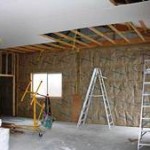Spray Foam for Barndominiums – Is a Thermal or Ignition Barrier Required?
Although it’s certainly not used in every green building project, spray foam insulation has become a popular way to build an air-tight (https://www.hansenpolebuildings.com/2019/11/airtight-post-frame-homes-and-barndominiums/) barndominium, shouse (shop/house) or even just a well-insulated post frame building. Early on building codes hadn’t caught up with how best to use spray foam insulation, however this has changed. Change creates confusion though, and requirements for thermal and ignition barriers are one area where there is a lot of confusion.
If you put spray foam insulation in a barndominium, it needs a thermal barrier. This is what separates it from occupied spaces. If there is a fire in your barndominium, a thermal barrier keeps separates combustible spray foam and flames to increase fire resistance. International Residential (IRC) and International Building Codes (IBC) both include requirements for thermal and ignition barriers.
 Standard prescriptive material to be used as a thermal barrier is 1/2″ gypsum board (drywall or sheetrock). Anything else has to be approved as an ‘equivalent thermal barrier’ by undergoing tests for temperature transmission and fire integrity.
Standard prescriptive material to be used as a thermal barrier is 1/2″ gypsum board (drywall or sheetrock). Anything else has to be approved as an ‘equivalent thermal barrier’ by undergoing tests for temperature transmission and fire integrity.
If a barndominium has spray foam insulation in an attic or crawl space, code requires using materials or assemblies offering some fire resistance but not as much as is required for a thermal barrier. If you’ve got spray foam insulation in an attic, for example, it’s probably already separated from living spaces by a thermal barrier. Most ceilings are made of 1/2″ or 5/8” drywall. But spray foam is still attic exposed and thus needs an ignition barrier.
In this case, you have a choice of several prescriptive materials approved by code as ignition barriers. These would include: 1.5″ mineral fiber insulation, 1/4″ wood, 3/8″ particleboard, 1/4″ hardboard, 3/8″ drywall or 0.016″ corrosion-resistant steel.
You can also use specialized paint, such as TPR FIRESHELL®. FIRESHELL® is a proprietary non-flammable, intumescing (expands up to 2000%) interior coating providing oxygen starvation to fire. It is a non-toxic, water based, drain safe, no fuming GREEN product. FIRESHELL® is NFPA 286 and E84 class A certified and meets the requirements for a 15 minute thermal barrier. FIRESHELL® does cost around 85 cents per square foot.
Other materials and assemblies may be allowed based on International Code Council Evaluation Service tests as described in their Acceptance Criteria 377. There are limited types of spray foam insulation qualifying to be sprayed without an ignition barrier.
When do you need an ignition barrier? According to Code, an attic or crawl space needs an ignition barrier over spray foam if it can be accessed but will not be used for storage or auxiliary living space. You don’t need an ignition barrier if these spaces cannot be accessed without cutting into it and if it is not connected to other spaces.
Building Code enforcement of spray foam insulation is spotty. Some jurisdictions are sticklers about it and some don’t even know about it. Best policy, as always, is to find out what they require and what they’ll accept. Then use your best judgement and err on the side of being conservative.
One thing to be aware of is not everything claiming to be a thermal or ignition barrier actually meets requirements. If it’s not on your building department’s approved list, ask the company selling it for their test data and evidence of code approvals. You may need them to satisfy your building inspector.
What if your local Building Department doesn’t require anything? Well, it sure is tempting to keep your costs low and omit ignition barriers in attics and crawl spaces. But what if your barndominium burns, and insurance company refuses to pay because there was no ignition barrier? Keep in mind, insurance companies hire people like me (and smarter) to find ways to keep from paying out. No ignition barrier? It shouldn’t take a genius to know you are out of luck!
Bottom line is if you are using spray foam insulation, know applicable code regarding thermal and ignition barriers and use them where necessary.






